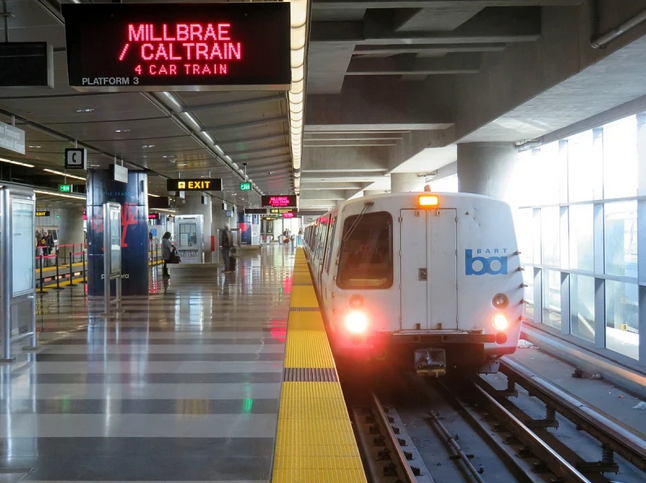Note: GJEL Accident Attorneys regularly sponsors coverage on Streetsblog San Francisco and Streetsblog California. Unless noted in the story, GJEL Accident Attorneys is not consulted for the content or editorial direction of the sponsored content.
The "fiscal cliff" that transit advocates are ringing bells about lately is no joke. Pandemic-era federal assistance for transit operations is about to end, but ridership and revenue have not fully recovered from pandemic losses. The budget gap is not something that transit agencies can just fix by themselves; any potential action they could take - cutting service, raising fares - would have to be so massive that transit would be almost useless, and would lead to further drops in ridership and revenue in a downward spiral.
The advocacy coalition "Survive & Thrive," in a letter to the legislature requesting transit funding, uses the Bay Area Rapid Transit District (BART) as an example. To achieve the savings needed to meet its budget, "BART would need to cut service by 65 to 85 percent, eliminating access to jobs, schools, grocery stores, and other essential services for many current riders. This, in turn, would further reduce passengers, leading to further cuts."
Survive and Thrive is coordinating a push to find transit funding, asking people to help out by calling their legislators, getting their city to send a letter, signing the petition, and volunteering to help spread the word. Information about how to do all of these things is available on their website.
Transit is not just a nice amenity. It is a crucial lifeline for many people, which is why the federal government unhesitatingly provided funding to keep it going during the pandemic, for those people who had to get to work despite the shutdowns. Recent research shows that when transit disappears or is greatly curtailed, poverty and unemployment increase.
The coalition, in its letter to the legislature, points out that
...almost sixty percent of California residents who commute via public transit have a household income below $35,000. Over half a million California households own no vehicle and count on public transit for their daily needs, including access to K-12 education and college. Public transit is an economic lifeline for these residents, especially seniors and persons with disabilities. Yet residents of all income levels also depend on transit to access their jobs and maintaining the viability of the transit systems is essential for the future of the state’s economy and quality of life. Public transit also supports good-paying jobs, employing over 31,000 California workers statewide in FY [Fiscal Year] 2021.
Even more than being crucial to personal survival, transit is absolutely necessary for environmental, climate, safety, and livability reasons. Our cities need buses. Even the simple geometry problem of space for all the number of cars in our cities becomes impossible to solve without transit. The California Air Resources Board "has urged the state to support efforts to double local transit coverage and service frequencies by 2030" writes the coalition in its letter. "Without a multi-year commitment of state funds to help sustain transit and put it on a path to attracting millions of new riders, the state’s climate strategy is in serious jeopardy," says the letter.
There are few statewide sources of operations funding, and it's not obvious what, if any, conversations are happening around creating more. Governor Newsom proposed to cut transit capital funding, rather than hold it steady. The Senate formed a Select Committee on Bay Area Transit, but it hasn't met yet. The Survive and Thrive coalition plans to send its letter to legislative leaders and budget committees ahead of the Governor's May budget revision, asking for a short-term but multi-year commitment to fund transit operations, to give transit agencies the time to develop long-term funding plans.
The funding picture for each transit system is unique and there is no one-size-fits-all path to financial sustainability. While some agencies need assistance to stave off service cuts next year, other agencies face deficits in the hundreds of millions of dollars starting in FY2024-25 or FY 2025-26. Others may not face near-term service cuts but have priorities that, if funded, could attract significantly more riders (advancing the state’s climate goals) and help avoid budgetary challenges down the road.
The letter has already been signed by multiple transit agencies and advocacy organizations throughout the state, including the California Coalition for Clean Air, the Greenbelt Alliance, NRDC, Seamless Bay Area, Climate Resolve, 1000 Grandmothers for Future Generations; 350; Asian Pacific Environmental Network; Bay Area Council; California Environmental Justice Alliance; Center for Independent Living; MoveLA; Peninsula Interfaith Climate Action; San Jose State University, Associated Students; Sierra Club; and Silicon Valley Leadership Group - among numerous others.






